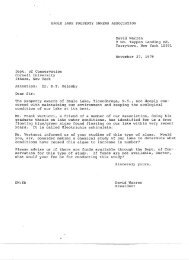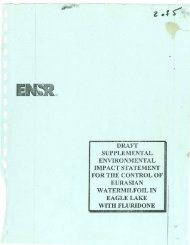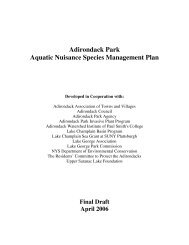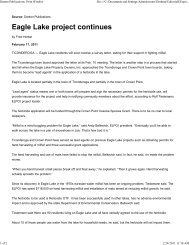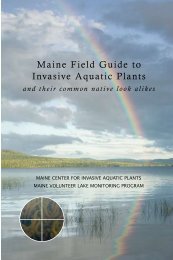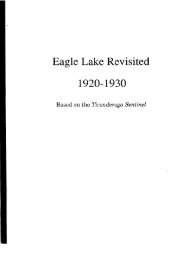Create successful ePaper yourself
Turn your PDF publications into a flip-book with our unique Google optimized e-Paper software.
<strong>Hemlock</strong> <strong>Woolly</strong> <strong>Adelgid</strong><br />
http://www.dcnr.state.pa.us/forestry/woollyadelgid/index.aspx<br />
PA STATE AGENCIES<br />
ONLINE SERVICES<br />
What is the <strong>Hemlock</strong> <strong>Woolly</strong> <strong>Adelgid</strong>?<br />
Adelges tsugae, the hemlock woolly<br />
adelgid, is a fluid-feeding insect that<br />
feeds on hemlock trees throughout<br />
eastern North America, including<br />
Pennsylvania. The egg sacs of these<br />
insects look like the tips of cotton<br />
swabs clinging to the undersides of<br />
hemlock branches.<br />
<strong>Hemlock</strong> woolly adelgid was<br />
introduced from Asia into the Pacific<br />
Northwest in 1924. It was probably<br />
introduced into the northeastern US<br />
in the 1950's, and it was first<br />
discovered in Pennsylvania in 1967. This insect has been damaging<br />
hemlock ever since, and it is spreading. To date, 49 Counties in the eastern<br />
two-thirds of PA have been infested with this insect.<br />
<strong>Hemlock</strong> woolly adelgid has two generations per year in Pennsylvania. All<br />
populations are made up of females that reproduce asexually. In early<br />
spring, overwintering females lay between 100 and 300 eggs in the woolly<br />
egg sacs beneath the branches. Mobile larvae, known as crawlers, emerge<br />
from the eggs in April or May to search for suitable feeding sites. Wind,<br />
birds and mammals<br />
often spread crawlers to<br />
nearby hemlocks. Once<br />
settled at the base of<br />
hemlock needles,<br />
crawlers become<br />
immobile nymphs which<br />
feed and mature into<br />
wingless or winged adult<br />
females by early<br />
summer. The winged<br />
form will die after<br />
searching for a suitable<br />
spruce tree that is not<br />
found in North America.<br />
The wingless form lays another 100 to 300 eggs on hemlock. Crawlers<br />
emerge from these eggs to search for suitable feeding sites. Once settled,<br />
the hemlock woolly adelgid becomes dormant until October or November,<br />
when it resumes development. Feeding continues throughout the winter and<br />
early spring.<br />
Eastern hemlock (Pennsylvania's state tree) and Carolina hemlocks (found<br />
1 of 2 5/28/2008 3:00 AM
<strong>Hemlock</strong> <strong>Woolly</strong> <strong>Adelgid</strong><br />
http://www.dcnr.state.pa.us/forestry/woollyadelgid/index.aspx<br />
further south in the Smokey Mountain sections of the Appalachians) are<br />
more susceptible to hemlock woolly adelgid damage than Asian and<br />
western hemlock trees due to feeding tolerance and predators that protect<br />
the latter species. <strong>Hemlock</strong> woolly adelgid sucks fluid from the base of<br />
hemlock needles. It may also inject toxins into the tree as it feeds,<br />
accelerating needle drop and branch dieback. Although some trees die<br />
within four years, trees often persist in a weakened state for many years.<br />
<strong>Hemlock</strong>s that have been affected by hemlock woolly adelgid often have a<br />
grayish-green appearance (hemlocks naturally have a shiny, dark green<br />
color).<br />
Other factors can influence the impact of the hemlock woolly adelgid. Other<br />
insects, such as elongate hemlock scale, hemlock borer, and spittlebugs,<br />
which are also found on hemlock, can compound the impact of hemlock<br />
woolly adelgid. Drought and fungi, such as Fabrella or Korfia tsugae can<br />
weaken hemlock and cause it to become more susceptible to insect<br />
damage. Low winter temperatures, cold snaps (episodes of freezing and<br />
thawing), and heavy thunderstorms can reduce populations of the hemlock<br />
woolly adelgid. Particularly in the mountains, it is not uncommon to find<br />
hemlocks where the insect has been killed on the top third of the trees,<br />
where it's colder and windier, but survive on the bottom two-thirds. On the<br />
other hand, mild winters can result in sharp increases in hemlock woolly<br />
adelgid populations.<br />
Home · Contact · FAQ<br />
2 of 2 5/28/2008 3:00 AM



